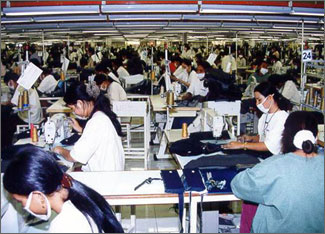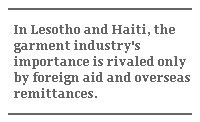Tangled Threads of Protectionism – Part II
Tangled Threads of Protectionism – Part II

WASHINGTON: Late in the 17th century, direct sea trade opened between Britain and India. The immediate result was a barrage of complaints about textile imports. Daniel Defoe, the author of Robinson Crusoe and a part-time wool industry lobbyist, wrote in his monthly newsletter that Asian competition threatened British manufacturing with "utter ruin." Three hundred years later, a new round in the east-west textile debate is opening, as the European Union and Bush administration launch investigations into surging imports of Chinese-made shirts, pants, and underwear.
The likely outcome appears to be a new set of limits, lasting up to four years, on trade in Chinese clothes. But many of the Asian governments that once railed against such policies now quietly welcome the prospect. Others in Africa, Latin America, and the Middle East do so as well. Why this change of heart? Beneath the statistics are emotional questions involving the most intimate of products, from the hopes of nations for development to the aspirations of the rural poor for cash incomes and urban jobs.

For most of the last 40 years, the United States and European Union (plus a few smaller wealthy countries) managed their textile trade through a quota system unique in manufacturing. These numerical limits were imposed on particular types of goods – T-shirts, bedsheets, suits – from particular countries. Though intended to keep textile jobs in the rich world, the system failed to do so. Instead, textile manufacturers spread themselves around the world.
The quota system did, however, achieve two things. It raised the retail price of textiles in the developed world, and it caused constant resentment among poorer countries that saw the quotas as an arbitrary and obnoxious form of discrimination. Their principal demand in the trade negotiations of the 1980s and 1990s was to abolish it. And last New Year's Day, under an international trade agreement dating to 1994, they succeeded.
By the late 1990s, the garment export industry operated in well over 100 countries, employing as many as 30 million developing-country workers – often young women finding their first urban jobs. Some of the countries, with weak infrastructure, high costs, or lack of cotton and fabric production, could only marginally sustain garment manufacturing. Their governments, though, often saw the industry as indispensable for national industrial development and even political stability. Watching the meteoric rise of China, some of them changed their minds about the quota system.

Many had begun to see the system less as a ceiling on their exports than a floor beneath them. The textile business has been key to Central American development and national reconciliation since the wars of the 1980s. The half-million new jobs in urban garment factories meant easier employment for young people, and the US$8 billion in export revenue signaled an end to the constant economic risks of dependence on volatile commodities like coffee, oil, and fruit. Together, new and steadier growth helped create a vastly better political climate. Likewise, after Cambodia's decades of war, its 200 garment factories and 240,000 workers represent the country's first major success in industrial development. In Mauritius, one in six workers is a textile employee; for the economies of Lesotho and Haiti, meanwhile, the garment industry's importance is rivaled only by foreign aid and remittances from overseas emigrants.
By the turn of the century, these countries and many others had come to fear that the end of the system would bring not rewards, but new competitive pressures and potential job losses. China's combination of size, low costs, skilled workers, superior infrastructure, and close ties to neighboring textile manufacturers made it appear an unbeatable challenger in apparel production.

Were their fears justified? The results, still early and partial, for now show no sudden wholesale change. For the US, clothing imports actually rose more slowly than total imports. Some suppliers thought highly vulnerable continued to see exports rise: Cambodia, Bangladesh, Central America, and Lesotho among them. But China far outstripped its competitors, accounting for the majority of US textile import growth. For example, in January and February of 2005, US stores imported 2.2 million more pairs of men's pants than in the first two months of last year. Combining imports from Hong Kong, mainland China, Macao, and Taiwan, China's garment complex accounted for 1.5 million of the extra imports. And even the countries which seem initially successful after quotas worry about the future.
The Chinese surge may soon subside. The US and Europe have invoked a special feature of the 1999 agreements through which China entered the WTO, enabling them to reimpose quotas on China, at least partially, until the end of 2008. Given that the Bush administration and European Commission themselves have launched these safeguard investigations, new restrictions seem close to inevitable.
What happens then?

First, a major trade collision seems unlikely. China's rapid rise as an exporter – combined with its artificially depressed currency and attendant contribution to the swelling US trade deficit – is bringing calls from Washington for import restrictions. The US Senate's threat in April to impose an across-the-board tariff on Chinese-made goods is a sign of the new mood. The textile investigations, tame in contrast, are consistent with a special clause of the China's WTO accession agreement. Thus, especially if China is willing to respond to the currency complaints, the clothing step may ease the pressure rather than raise it.
Second, the smaller countries get a reprieve – a short one, which they need to use well. When the "safeguard" feature expires at the beginning of 2009, all quota options will be gone. So countries hoping to remain successful in the 2010s must make their products more competitive and attractive to buyers. For instance, Pakistan and, more recently, Egypt have lowered costs and improved quality by easing imports of textile inputs. Another approach comes from Cambodia, which emphasizes high labor standards and International Labor Organization (ILO) certification of garment factories to its ethics-conscious buyers.
Third, US textile makers may benefit less than they expect. The drastic solutions of Defoe's day – the British Parliament twice banned the wearing of cotton clothes altogether – did not work. Nor have the modern quotas kept jobs in the United States. Upon the system's inception, well over one million Americans worked in the garment industry; by the time it lapsed, the total was below 300,000. Restoring quotas on one country, even China, is unlikely to reverse this trend; India, Indonesia, Vietnam, Pakistan, and others can easily pick up the slack. As in earlier bouts of the textile debate, the challenge to US industry is to find a new approach, to succeed through opening foreign markets and exporting high-tech fabrics and yarns.
One thing, though, is certain: A 300-year-old debate is not about to end soon. The sheer size of the industry, as Pietra Rivoli writes in her exceptionally informative new book, "The Travels of a T-shirt in the Global Economy," simultaneously renders it a path to industrialization for poor countries, a target for anti-globalization groups, a road to independence for the young female apparel workers, and an industry where the human face of trade is most controversial. New restrictions on Chinese textile export are only the latest phase.
Edward Gresser is Director of the Progressive Policy Institute’s Project on Trade and Global Markets.